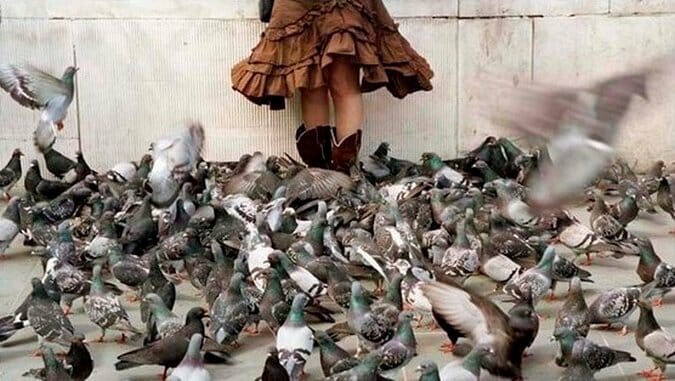
In the 1930s, Henri Cartier-Bresson painted the chrome parts of his Leica camera black and lit out across the streets of Europe to capture people in the act of living their lives. Inspired by the Surrealists, he believed that remaining invisible to his subjects would allow him to depict the world in its actual, candid condition. His eye craved the curious geometric pattern, the odd juxtaposition, the absurd moment. Shunning many of the technical elements of photography, he focused on an instant when Zen-like patience and alertness brought his finger to click the shutter.
Cartier-Bresson set the course of modern photojournalism and most shooters recognize him as the father of street photography. But what exactly is street photography?
The Street Photographer’s Manual, London-based photographer David Gibson’s how-to guide, broadly defines the term as any kind of photography taken in a public space … usually the photography of people going about their everyday lives. Gibson, though, clearly sees more. A direct philosophical descendent of Cartier-Bresson and a purist, he insists that the photographer must never impose himself upon the picture. For Gibson, “street photography’s core value is that it is never set up; this aspect is ‘non-negotiable’ because the guiding spirit of street photography is that it is real.”
Humans of New York? Vivian Maier? By Gibson’s strict definition, these artists create street portraits, a bastard subgenre maybe, but certainly not street photography.
It is one of the most common misconceptions about street photography, where photographers believe they are practicing street photography even when they interact with their subject who might acknowledge and approve of being photographed and even pose for the shot, too. This is not street photography; it’s taking a staged portrait. Unfortunately, street portraits are ubiquitous on street photography blogs and web pages, which is misleading and somewhat false.
So there.
Despite Gibson’s dogmatic posturing, The Street Photographer’s Manual offers a trove of practical and technical tips for the budding street photographer. In five broad categories (Busy, Quiet, Abstract, Still and Subjects), Gibson analyzes the methods and works of several contemporary street photographers, while illustrating many of his points using photos from 20 different photographers (like Cartier-Bresson, Marc Riboud, Robert Frank, Martin Parr … and one David Gibson).
In a section about staking out an interesting location and waiting for the photographic moment to arrive, Gibson advises concealing intentions as long as possible, lest a subject-to-be politely wait to the side of the frame to avoid disturbing a shot. Another section addresses the wealth of photo opportunities in surface reflections: a street photographer should become aware of reflections and consider unusual surfaces, should know that rain intensifies – and saturates – color on the streets.
United States-based street photographer and blogger Eric Kim counsels the reader to buy books, not gear, and to avoid the easy lure of capturing homeless people and street performers. “Despite their assumed exoticism,” Kim notes, “they rarely make good photos.”
Gibson gives solid advice on digital cameras, like “the ISO setting is important – even on a fairly bright day you may still set the ISO at 400 or even 800 to get a decent shutter speed” and “it is better to be slightly underexposed; and always shoot in RAW mode.” Chockfull of tips (some perhaps obvious), Gibson teaches, coaches and encourages the shooter to consider the full range of photographic opportunities, both technical and circumstantial, and to foster “thinking like a street photographer.”
The Street Photographer’s Manual also holds a collection of street photographs, including Gibson’s work. Every photographer faces the choice whether to frame and compose the shot horizontally or vertically. To illustrate the importance of the decision, Gibson contrasts two shots of a couple seated in Trafalgar Square as a wedding couple scurries up steps beside them. In the horizontal image, the busy space between the two couples becomes a distraction. In the vertical shot, both couples fill the frame and the eye goes to the lines and patterns of the image.
The topic of obsession with one’s work calls for a Martin Parr image, this one a satiric close-up of a Spanish noblewoman, her head resting against a blue towel, eyes hidden behind blue sun shields, her glossy red lips and clunky gold earrings and necklace greedily soaking up the sun.
In a 1950s Vivian Maier black & white (taken from behind, so this Maier image passes Gibson’s sniff test for authentic street photography), a woman in a white evening dress and white fur stole strolls across a darkened parking lot to a waiting Chevy coupe. This shot demonstrates the quality of quietness.
Of Maier, Gibson says, “Her street photographs, some of which can be considered street portraits, are not exclusively quiet. She photographed on busy streets, but her silent approach has been rediscovered in the Internet age.”
As with the best photography, the Maier image leaves a viewer with questions and few answers. Whither the elegant woman in white, and why?
Gibson challenges the photographer to boldly go where no man has gone before, to get up close and personal for that perfect shot – but not so close you affect the shot. Street photography is not for the timid, and the close-up photo usually packs more wallop than a long shot. In the U.S., the photographer generally enjoys a First Amendment right to take photos of other people in public places, but elsewhere in the world, the individual’s privacy rights may prevail.
And what of the often furtive nature of the art, the implicit voyeurism, even sometimes the stalking of a subject in search of the shot? Gibson insists you cannot do street photography if you are anxious about people’s reactions. What’s more, if you get caught by your subject, then you’re obviously doing it wrong.
“The ethical principal underlying the practice,” says Gibson, “is simply respect for other people.”
Mark Baker is an entertainment lawyer, musician, photography and art dealer, and collector living in Atlanta.